
- 404 pages
- English
- ePUB (mobile friendly)
- Available on iOS & Android
The Political Economy of China's Belt and Road Initiative
About This Book
-->
Silk Road was once the most important economic-cultural tie connecting the Eurasian countries before the rise of the West. In September 2013, Chinese President Xi Jinping put forward the initiative to jointly build the Silk Road Economic Belt and 21st-Century Maritime Silk Road, which is abbreviated as the Belt and Road Initiative (BRI). This book analyzes the BRI through the approach of political economy and establishes the analytic framework of BRI from historical and comparative perspectives. It clearly displays the strategic considerations, future vision, constructing framework, governmental actions, latest achievements, multiple opportunities and potential risks of BRI.
As China's grand national development strategy and international cooperation initiative, the BRI will largely shape China's domestic and foreign policies in the Xi Jinping era. The book is the first academic monograph on the BRI and it enables readers to comprehensively understand this initiative and its implications to China, Eurasia and the world.
--> Contents:
- Reflections on the Ancient Silk Road
- The "Modern Silk Road" between China and the Middle East
- Understanding China's Belt and Road Initiative in the New Era
- Cooperation Framework of Building the Belt and Road
- Development Opportunities of the Belt and Road Initiative
- Government Actions on Building the Belt and Road
- New Developments of Building the Belt and Road
- Risk Management in Building of the Belt and Road
-->
--> Readership: Academics, policy-makers, professionals, undergraduate and graduate students interested in China's Belt and Road Initiatives, China's domestic and foreign policies in Xi Jinping Era. -->
Keywords:China;The Belt and Road Initiative;Silk Road;One Belt and One Road;Political Economy;EurasiaReview: Key Features:
- First monograph on China's Belt and Road Initiative
- Comprehensive and in-depth studies
- Rich first-hand materials
Frequently asked questions
Information
C h a p t e r
1
Reflections on the Ancient Silk Road
1.1Land–Sea Relations
1.1.1Transnational Communication via Land and Sea Routes
Table of contents
- Cover
- Halftitle
- Series Editors
- Title
- Copyright
- Contents
- About the Author
- About the Translator
- Introduction
- Chapter 1 Reflections on the Ancient Silk Road
- Chapter 2 The “Modern Silk Road” between China and the Middle East
- Chapter 3 Understanding China’s Belt and Road Initiative in the New Era
- Chapter 4 Cooperation Framework of Building the Belt and Road
- Chapter 5 Development Opportunities of the Belt and Road Initiative
- Chapter 6 Government Actions on Building the Belt and Road
- Chapter 7 New Developments of Building the Belt and Road
- Chapter 8 Risk Management in Building of the Belt and Road
- Conclusion
- Bibliography
- Index